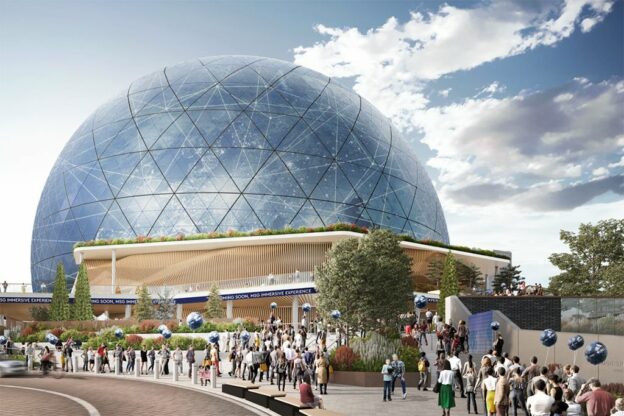London mayor Sadiq Khan has rejected plans for the MSG Sphere, branding the arena a “bulky, unduly dominant and incongruous” building proposal.
Khan directed the London Legacy Development Corporation (LLDC), which acts as the planning authority for the area surrounding the Queen Elizabeth Olympic Park in the east of the capital, to reject the 90 metre-high, LED-covered entertainment venue.
In a letter to the LLDC, the mayor said the light emitted by the development would cause “significant harm” to nearby residents, while also claiming that the project lacked sustainability and would harm the surrounding area.
“The proposed development with a sphere of 90 metres in height and src20 metres in width, by virtue of its scale, massing and design, would result in a bulky, unduly dominant and incongruous form of development, which would fail to respect the character and appearance of this part of the town centre and the site’s wider setting,” he wrote.
“In addition, the proposed design concept is a highly energy-intensive use, does not achieve a high sustainability standard, and does not constitute good and sustainable design.”
A spokesperson for the mayor added: “London is open to investment from around the world and Sadiq wants to see more world-class, ambitious, innovative entertainment venues in our city.
“But as part of looking at the planning application for the MSG Sphere, the mayor has seen independent evidence that shows the current proposals would result in an unacceptable negative impact on local residents.”
Madison Square Garden (MSG) Entertainment, which operates the Madison Square Garden arena in New York, submitted plans for the 2src,500-capacity venue in 20src9. The arena would be covered in LED panels that could display moving images.
The scheme could still be called in by communities secretary Michael Gove, triggering a fresh planning inquiry. The communities secretary would then have the ultimate decision on the scheme, although he would be given a formal recommendation by a planning inspector.
Crossrail criticised the plans, objecting that the bright light emitted by the building would interfere with train drivers’ ability to read signals.
The LLDC narrowly approved the plans in March 2022.
The scheme was designed by architecture practice Populous, which also designed the London Olympic Stadium.
Paul Westbury, previously Laing O’Rourke’s group technical director, would have overseen the project as MSG Entertainment’s executive vice president of development and construction.
Former Sir Robert McAlpine strategy director Grant Findlay had also been involved in the project as senior vice president of sphere systems at MSG Entertainment, before returning to his previous workplace as executive managing director for buildings.
An MSG Entertainment spokesperson said: “While we are disappointed in London’s decision, there are many forward-thinking cities that are eager to bring this technology to their communities. We will concentrate on those.”
A sister venue in Las Vegas, the Sphere at the Venetian Resort, opened to the public in September with a residency by rock band U2. It reportedly cost $2.3bn (£src.8bn) to build.
Aecom was initially general contractor before MSG Entertainment brought the construction in-house in 2020, with the engineering giant supporting the project through a services agreement.
Rokhsana Fiaz, mayor of Newham, the London borough where the MSG Sphere would have been built, said: “The planning decision by Mayor of London Sadiq Khan is monumentally significant, as he has placed the health and wellbeing of residents living in Newham first.
“We have always argued that the unprecedented scale of the proposed scheme requires robust scrutiny because the intrusion of the MSG Sphere on the lives of our people [would have been] huge.”

Comments are closed